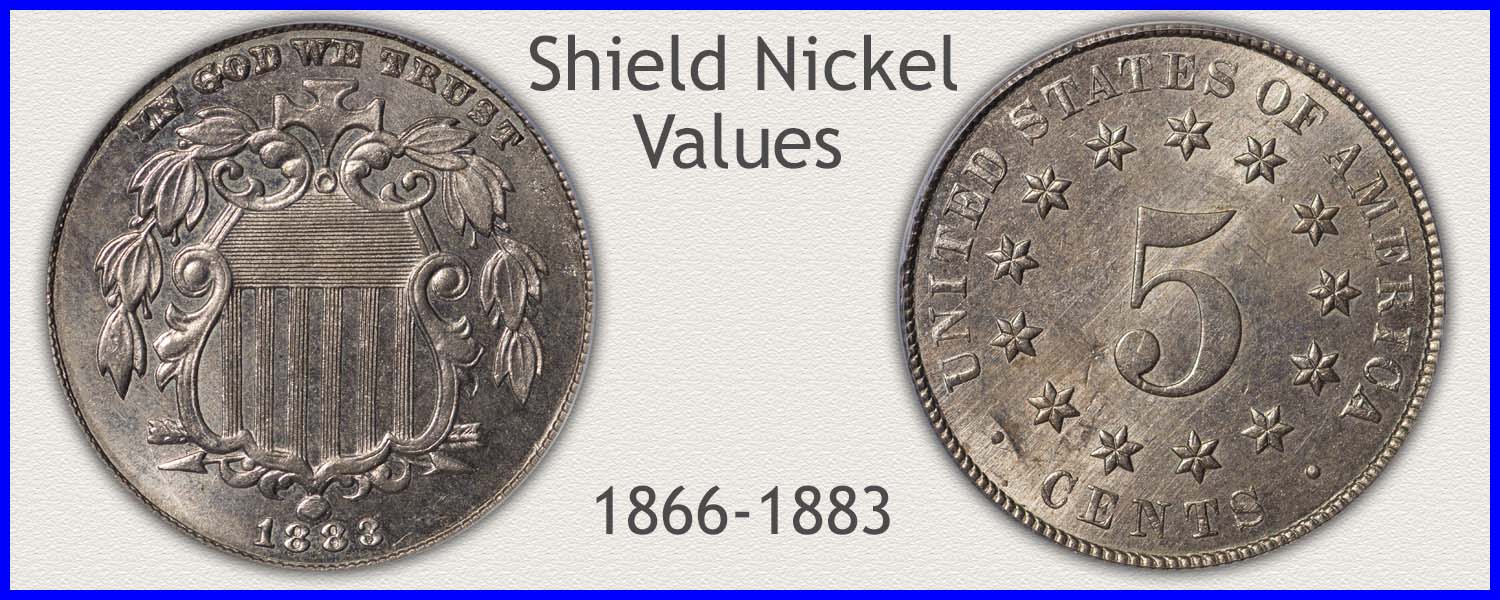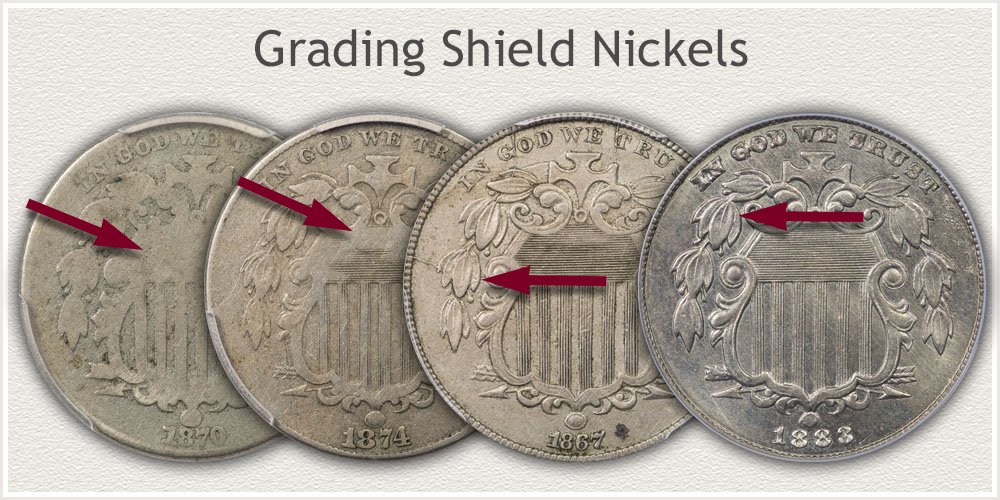Coin Values Moving with Precious Metals: Up-Dated 12/15/2025: Gold $4341 | Silver $63.26
1869 Nickel Value
With a high number produced, 1869 nickel value represents a solid base for the entire series. Fundamentally, all Shield nickels are scarce. These coins list at nice premiums in all stages of preservation. A step-by-step approach determines a description of the coin. This helps place it within a narrow range on the value chart.
Examine your coin, comparing it closely to images below. These identify the key market features important to collectors and dealers. To understand its potential, start with the chart. This range across the grading scale indicates how much an 1869 nickel is worth to you.
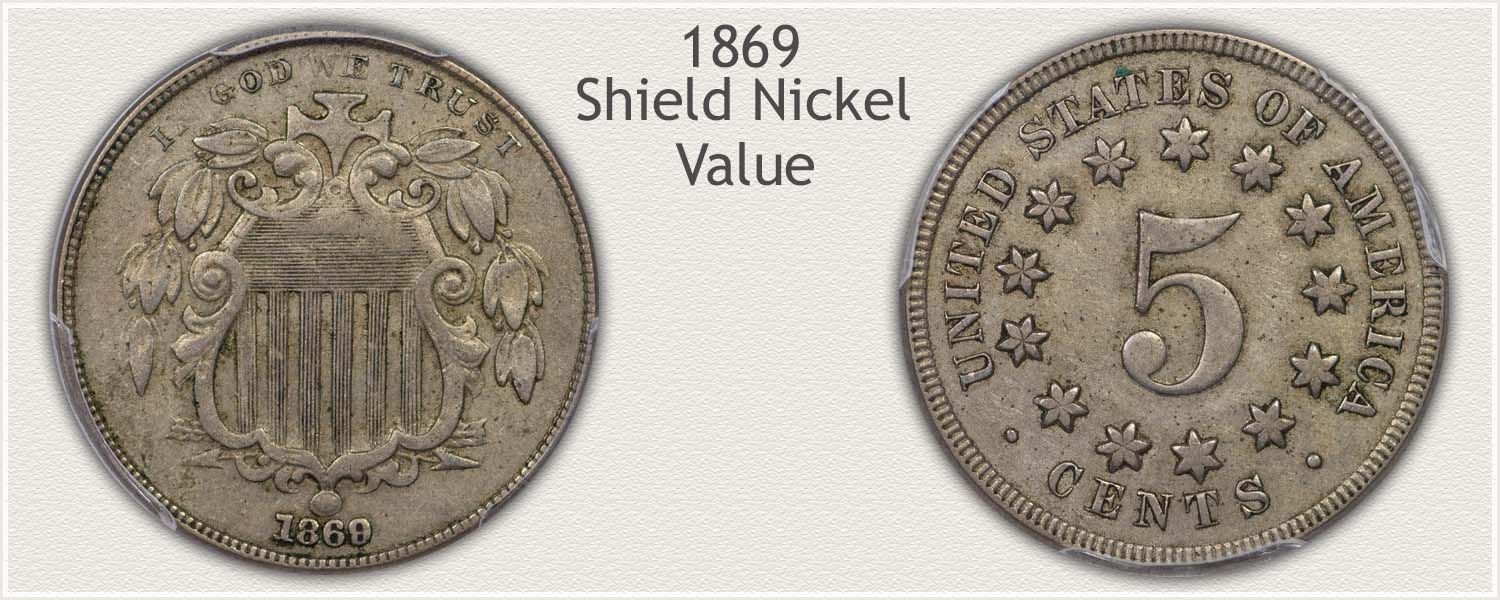
Steps Leading to Value:
- Step 1: Date Identified - All collectible nickels require an accurate reading of their date. The description depends on identifying the small and difficult to read six and nine. Always give the date a second, confirming check.
- Step 2: Grading Condition - With a comparison approach, use the grading images to judge your coin. A comfortable range of condition determines the coin's quality.
- Step 3: Special Qualities - 1869 is an early year of minting nickel alloy coinage. Often, the mint's difficulties show on their surface. Judge if any of these imperfections add or detract.
| 1869 Nickel Value | ||||
|---|---|---|---|---|
| Condition of Coin | ||||
| Date | Good | Fine | Extremely Fine |
Mint State |
| 1869 Nickel Value Updated | 2025 | |||
| 1869 | $22 | $26 | $56 | $150 |
Entries in the chart represent wholesale value ranges. A slight difference in a coin's condition contributes to higher or lower premiums. Additionally, market strength and dealer needs determine how much these nickels are worth.
Step 1: A Small Vintage Style Date Requires Magnification
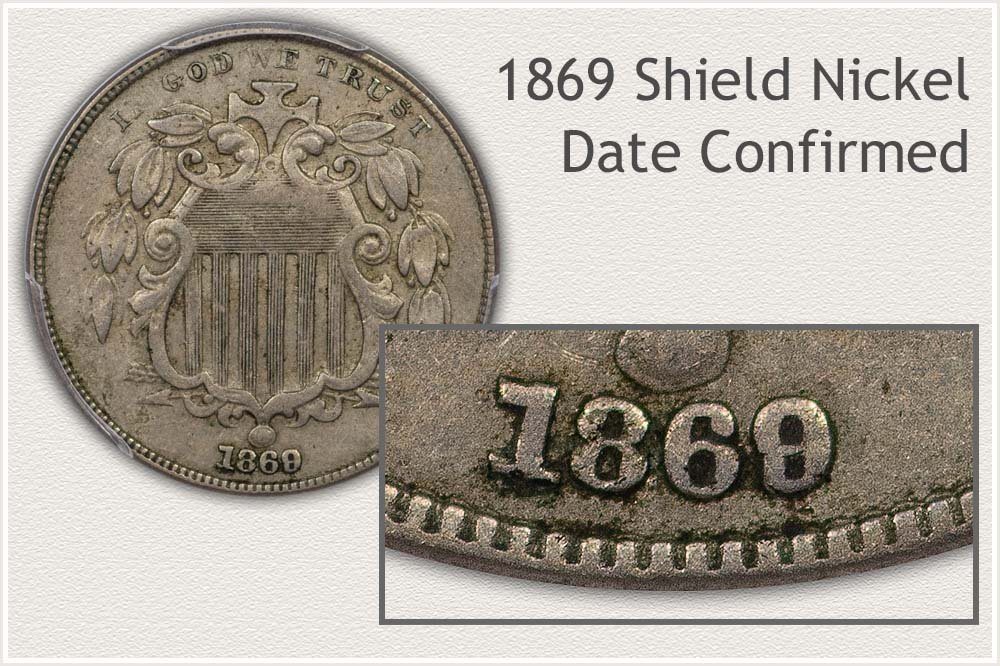
Recording a decrease in production, 1869 nickels are scarce coins. Philadelphia, the only mint sticking nickels, placed 16.3 million into commerce. This is half the number of nickels produced the previous year.
A collectible quality 1869 nickel has proven difficult to find. Many of the examples found today are heavily worn and suffer damage. A challenging year for collectors, it is also affordable throughout the condition scale. Experienced hobbyists consider it a "sleeper" date. This phrase refers to an undervalued coin in comparison to its availability.
A special date of the Shield nickel series, look below the shield to locate the date. It is recommended to magnify the date to confirm all digits. The small size and style of the numbers are easily misread. A year with value potential, grade its condition next.
Step 2: | Close-Up Views Help Judge Condition and Determine a Grade
Condition is a Key Factor of 1869 Nickel Value
Grading starts the process of rating a coin's condition. First judge surface features, and then, based on the amount of wear, assign a grade. Focus on the shield with its intricate lines, leaves, and frame details. Wear develops in recognizable patterns, indicating the amount of metal removed.
Considering the range of value per grade, small details, when present, add to a coin's appeal in the market. Start with a comparison of each image. The imaged coins represent standard grades. A close match with your coin begins to identify its condition. Descriptions then highlight key areas to gauge, and the important details per grade.
View the coin under a single light. A single light source casts strong shadows, bringing out subtle details. Tilting the coin and changing angles to the light helps as well.
Mint State Grade
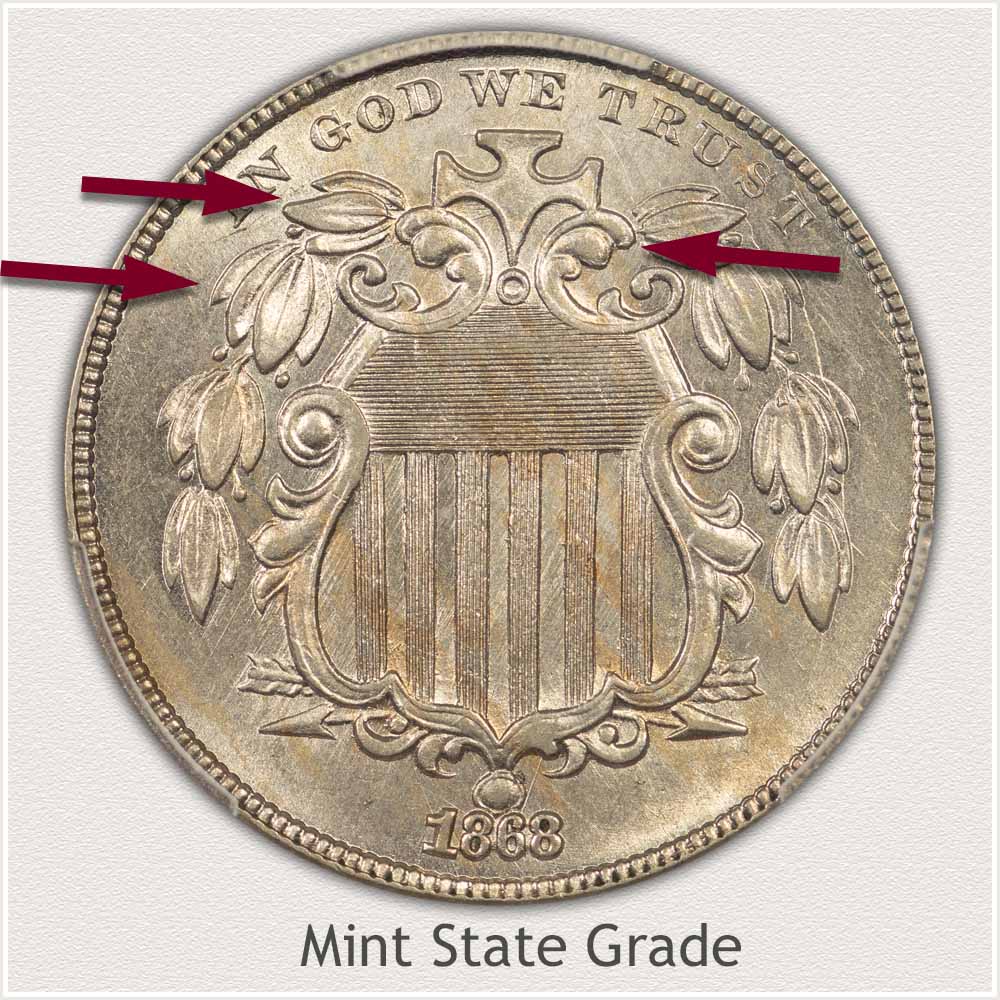
Mint State: A comparison of your coin to the image begins to identify its condition. When appearing similar, it is a possible Mint State grade nickel. Defining Mint State is a surface without any wear. Focus on the high areas of the example; notice there is no flattening of the tops on rounded contours. Leaf edges and areas of the shield frame wear first and used when judging quality.
An important feature is the presence of mint luster. This is the shine reflecting from the coin. A fine texture results when minting a coin, imparting a delicate surface texture. Coins retaining luster are strongly considered for the Mint State level. Additionally, a lack of luster alerts to worn areas.
The left side of the example provides good design detail to examine. Look first at the intricate features of the leaves. The grouping of leaves near the horizontal lines is especially useful. Focus on their high outer edges, low relief inner area, and central vein. High points have the same texture as inner areas, with the vein matching both.
Above the horizontal lines, a curved shield decoration provides additional grading areas. Crisp edges defining the curves show the shine of luster. Higher, rounded elements match closely with a similar texture. The slight color change on the metal is a soft toning, natural to nickel alloy that develops over time. Complete contours with no smoothing or flattening are the important metrics.
This example coin represents a Mint State condition Shield nickel. Results of inspecting the two areas helps develop an impression of your coin's condition.
Extremely Fine Grade
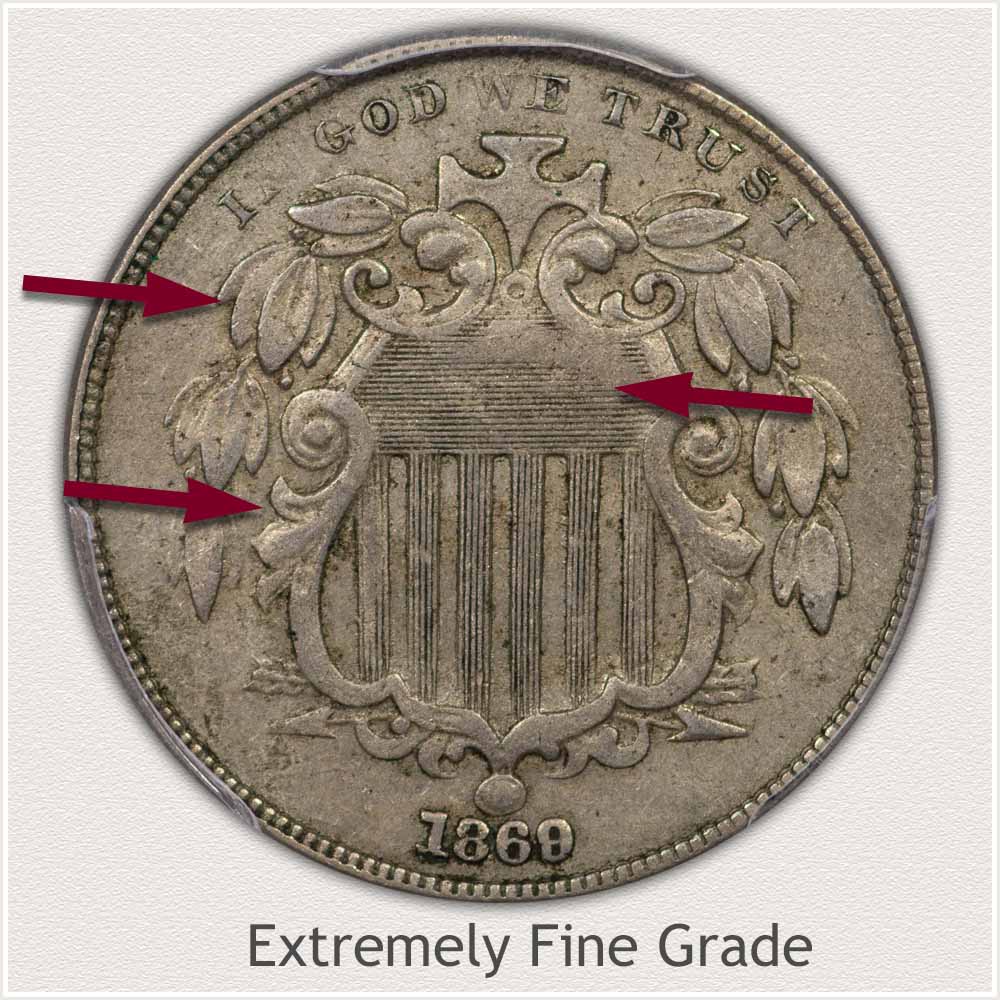
Extremely Fine: With an overall crisp look, the Shield nickel imaged is in high quality condition. Extremely Fine grade defines this condition as minor wear on high points only. Grading a coin applies standards to areas of the coin, gauging wear patterns. Specific amounts of detail remaining decides a coin's condition and grade.
Inspect from the center of the coin outward. Most horizontal lines within the shield are clear. Vertical lines remain sharp, with only a slight amount of weakness in spots. Framing the lines, a detailed border shows only light wear. Contours of the border show minor flatness, confined to the very tops. All the leaves surrounding the border are complete. Leaf edges show boldly. Strong edges keep each top leaf separate from those below.
A close match of your coin to the image begins to judge the Extremely Fine grade range. The cross above the shield provides a subtle detail, helping identify the grade. Light wear has begun to smooth the center surface of the cross. Note the faint raised border along the top edge of the horizontal arms. Wear has removed this border in many areas, indicating wear. Leaving partial edges on the cross, indicates light wear. This detail of some remaining border helps confirm the Extremely Fine grade.
Fine Grade
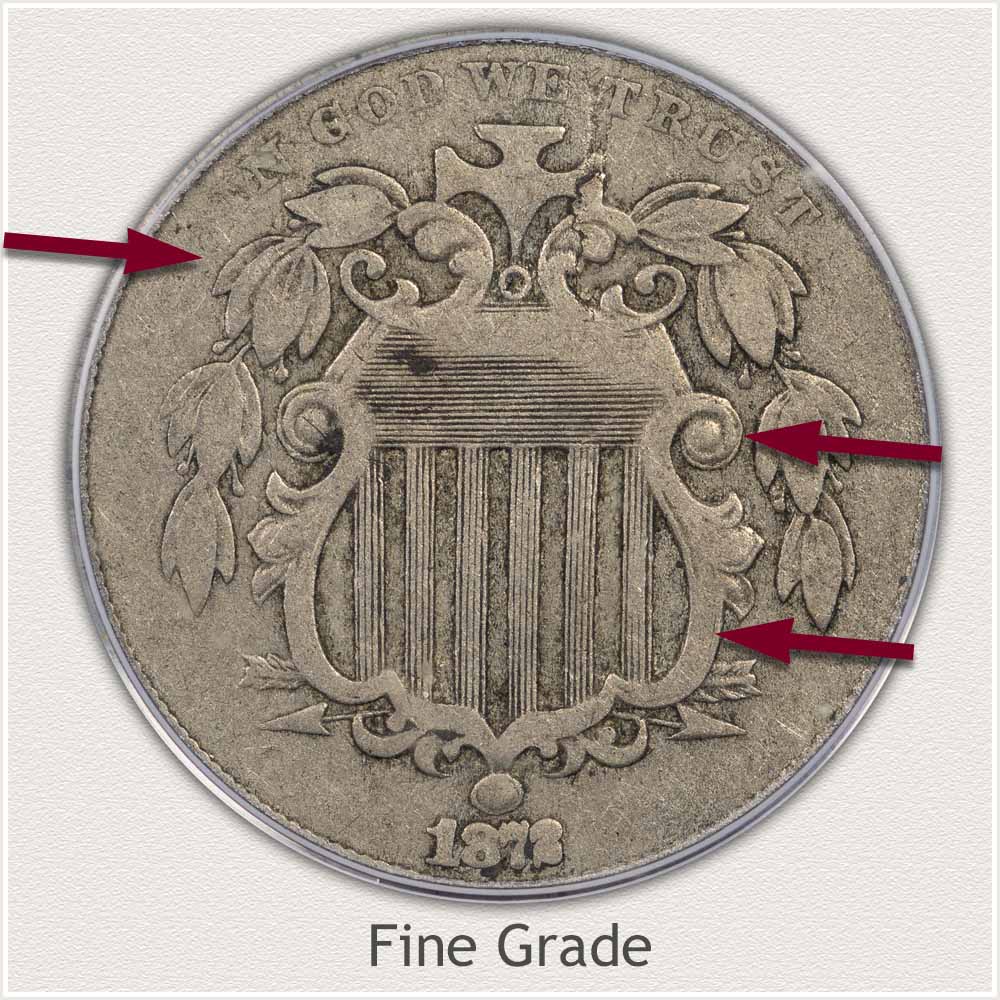
Fine Grade:
Notice in the image a balance of complete design features offset by flattened areas. Defined as moderate wear, many lower contour areas remain finely detailed. Only parts of high points are flat. Using a comparison method of your coin with the illustration, focus on the outer edges of the shield.The frame near the bottom of the horizontal lines is well detailed in Fine condition. Raised contours of the frame are visible on the spiral feature. The central ball device has some flatness confined to the very top. Moving downward, the frame is smooth. The next decoration has contours and recesses remaining. Finally, the lower frame is flat from wear. A combination of flat metal and raised contours indicates a moderate level of wear.
Leaf clusters outside of the frame provide the same comparison of wear and detail. Center detail in the leaves highlights the flat areas toward the tips and edges. At least half of the leaves remain with central detail, meeting the standard for the Fine grade.
A close match of your coin with the image narrows the grade range. Details showing within the frame, and primarily the top leaf of each group, points to the Fine grade.
Good Grade
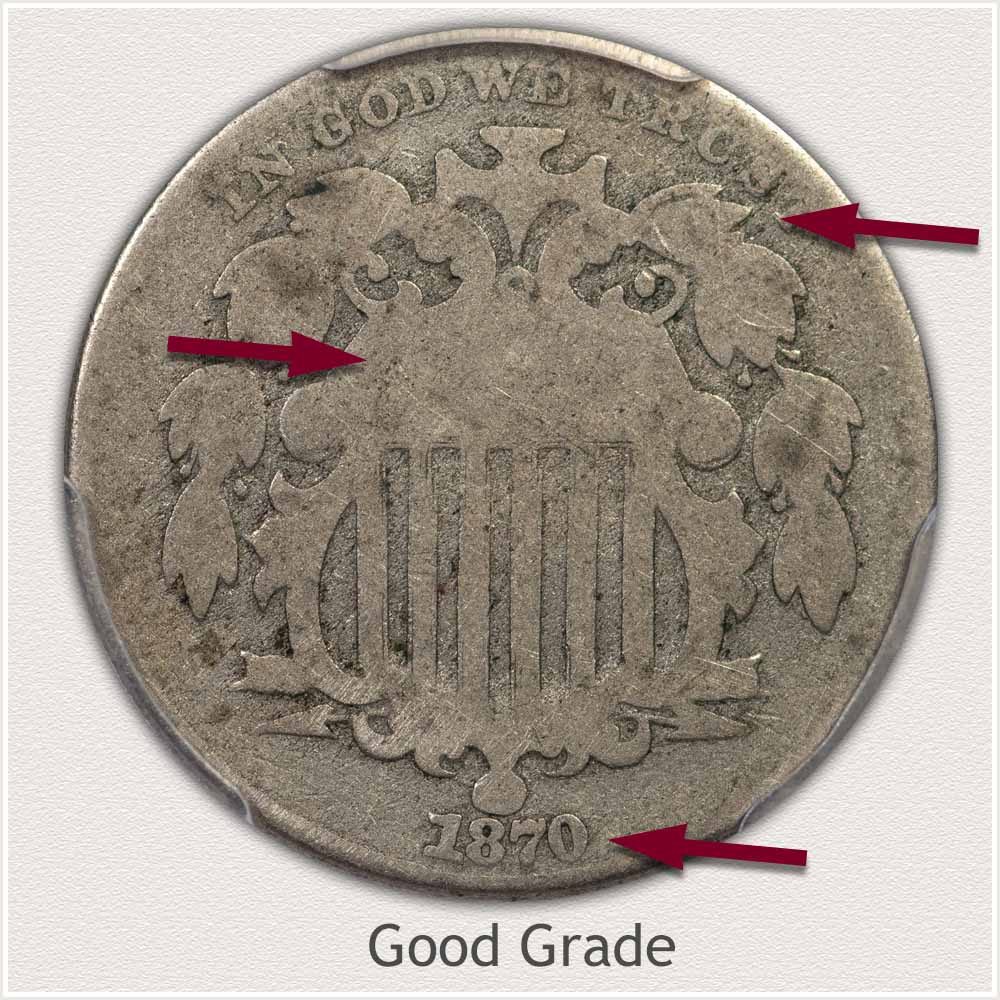
Good Grade: The coin market and collectors award 1869 nickels a nice value in "Good" grade condition. This premium depends on the condition meeting specific metrics. Overall, defining the Good grade describes a coin displaying heavy wear. Flattened devices and few inner details remaining visible further defines the grade. To qualify, major devices are complete. Inspect three specific areas, the shield, olive branches, and date to form an opinion of grade.
At the bottom of the coin, its date remains well defined. The date located close to the rim is somewhat protected. On the example coin, the bold date is well within the grade quality.
Next, olive branches display on either side of the center shield, starting at the top. Without interior detail within individual leaves, is a clear indicator of heavy wear. However, fully outlined leaf groups meet the grade standard. Both the inner and outer edges of the leaf groups display distinct and boldly raised above the field.
At the center of the design is a shield set in a frame. At this stage of wear, no separating lines define the shield from the frame. Importantly, the entire outline of the shield is bold. Inner vertical lines are at the shield's very center, each of which remains very strong.
A visually nice nickel without dark toning fits within collector quality and value. Verify completeness of the date, leaves, and shield. Completely outlined devices confirm a Shield nickel in Good grade.
How to Video: Grading Shield Nickels
Step 3: | Special Qualities | Surface Imperfections and Collectible Shield Nickels
Die Cracks and Their Appeal to Shield Nickel Collector
It is very possible when looking closely at these Shield nickels, you find "Die Cracks" on their surface. A "die crack" imperfection shows as raised lines of metal. Many of these cracks start at the rim, run through lettering, and continue across the surface. These are actual cracks in the coinage die, and when minted, transfer to the coins.
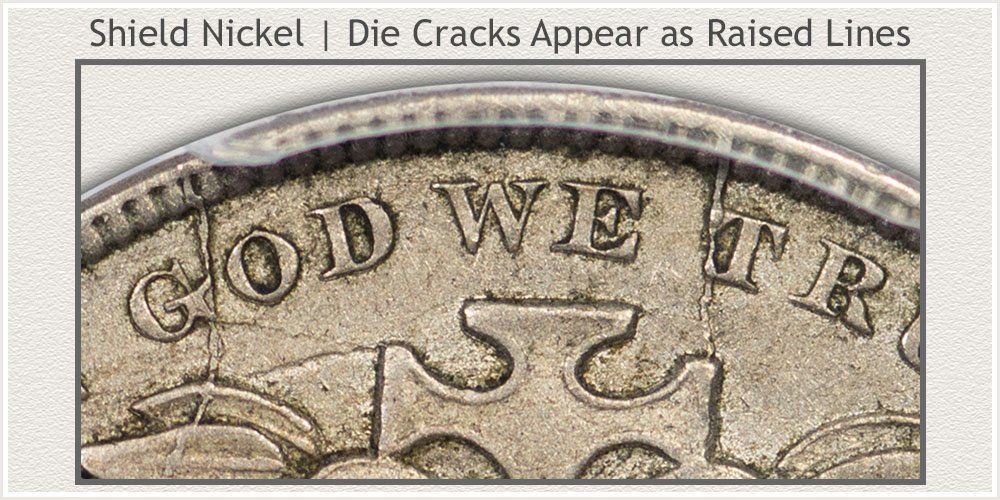 Die Cracks Through Motto of the Shield Nickel
Die Cracks Through Motto of the Shield Nickel
The motto "In God We Trust" has two die cracks passing through its letters. Between the "G" and "O" is a raised line, indicating a cracked die, starts at the rim. This line connects with the "G" and continues into the olive branch. A second crack begins at the rim, connects to the "T" and into the cross. These are deep and distinct.
Not all nickels have these cracks. Dies after extended use were vulnerable to breakage. The nickel-copper alloy in the coin is a hard and durable metal. Coinage dies suffered quickly.
These die crack examples are an exciting find. They interestingly show the trials and difficulties of producing nickel coins. Sizes and lengths of these cracks vary. From small and thin, to large cracks creating voids in the design.
Most die cracks do not add value to the coin. Many collectors seek coins without these anomalies, considering them distracting. Only the visually stunning cracks and die breakages gain attention as an error coin.
As pictured above, two broken areas of the die run through the motto. These minor cracks are an interesting, special quality of the first U.S. nickel coinage.
References
U.S. Mint. Catalogue of Coins of the United States
https://nnp.wustl.edu/library/book/554591
U.S. Mint. 1888 U.S. Mint Annual Report
https://nnp.wustl.edu/library/book/313
Coin Values | CoinStudy Articles
Date by Date
In Depth Shield Nickel Value
Shield Nickel Value | Complete Value Chart of All Years
Sixteen different years of Shield Nickels went into circulation. 1869 is among the dates popular with collectors. When comparing premiums of all dates, it becomes notable all are scarce.
How to Grade Shield Nickels | Visual Guide
Referencing the visual guide improves accuracy when grading Shield nickels. Examine in detail the subtle points of condition. Grading features on both the obverse and reverse are identified, helping determine condition. Additional close-up images point to the details of each grade.
Coin Value Guide | How to Value a Coin Collection
Place a value on a coin collection by following a step-by-step method. Identify each coin by comparing it to images, with important dates highlighted. Further steps inspect and grade its condition, an important consideration. Use images of different grades to determine the condition of each coin. Developing naturally are factual descriptions and organization of your collection.
Print (Printable) the Coin Values Worksheet
After following the steps above to evaluate coins. Print the worksheet and list your Shield nickels along with the rest of your collection. Record the important details and descriptions to accurately evaluate each coin. This written record organizes the holdings and records their current values.
Rare Nickels of the Twentieth Century
Many identifiable characteristics on nickels, such as mintmarks, and varieties are elusive. Making certain nickels truly valuable. Early Shield and Liberty nickels are basically scarce. The Jefferson and Buffalo series contains scarce mintage nickels. Highlights include collectible mint errors, and rare condition nickels.
★Coin Values Discovery finds 1869 Nickel Value and...
Old U.S. coin values. Use the step-by-step method outlined to evaluate and determine how much a box of old coins is worth. An emphasis on accuracy of the date, variety, and condition of the coin narrows its value range on the charts.
